Total Cost
1.1 Definition
Total cost is the sum of all fixed and variable consumed economic resources in production of a certain level output of a specific product. It entails the sum of fixed costs and variable cost. The cost that vary with level of output is referred to as direct cost and the one which is constant all through any level of output is referred to as fixed cost.
Mathematical Model (i.e., formula) expression is as follows;
Total Cost (TC)=Fixed Cost + Variable Cost (VC).
Tabular Model (i.e., formula) expression is as follows;
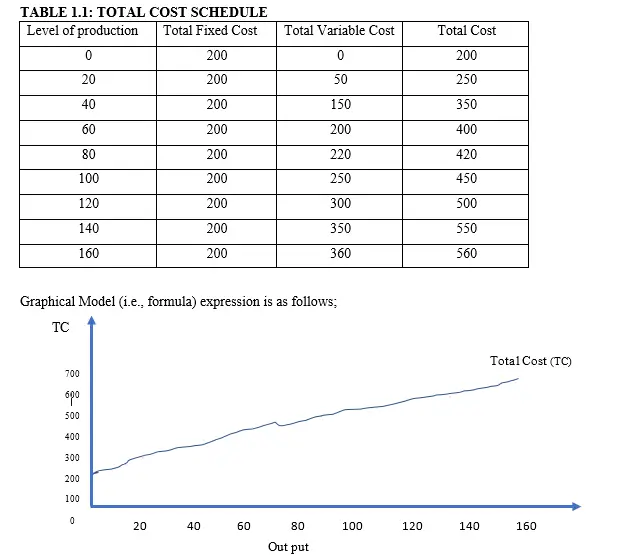
Advantages of Total Cost
The question that arises at this point is, why is it necessary for the manufacturer or producer to compute or determine the total cost of a product? The following are the advantages;
- Pricing of products
When the producer or manufacturer is able to determine the total cost of a product, he or she is also able to do correct or appropriate estimation of selling price which helps in ensuring that no over or under pricing.
- Demand forecasting
It is possible to guess or assess the level of demand of a product when the price is set. Such that if the price is a certain percentage of the total cost, one can know from the price set whether the demand will be high or low.
- Help in resource allocation
Allocation of resources in a particular project is based on the total cost incurred. Such that with proper determination of the total cost per project, one can rank them and prioritize them in the order of actual cost.
- Help in determination of opportunity cost
Opportunity cost is the monetary benefits forgone on choosing the best alternative. So, if the total cost is not well computed, then the opportunity cost may not be well articulated.
-
Help in determination or computation of derivative cost elements such as average cost, average fixed cost, average variable cost and marginal cost.
That is, all the derivative costs used in Economics originate from total cost concept.
- Knowledge on the total cost helps in increasing competitive edge
When an entrepreneur is in a position of determining the actual total cost of his products, it becomes easy to attract more customers by adjusting the prices downwards to out compete his contesters in the market.
- Safeguarding the profitability of the business
If a manufacturer or producer is in a position to determine exactly the total cost of a product, the determination of profits is sure and no misleading figures which may translate to losses without knowing.
Disadvantages of Total Cost
- Hard to ascertain correctly the value of total cost
All costs involved in production of a particular product may either be many or technical to establish and this creates a loophole of failing to capture all the costs
- The concept is not universally appreciated
Mostly with small and medium enterprises, owners rarely value the idea of capturing all the total cost of a product and so they just produce and sell their products in the market as long as they are making ends meet such as having a market.
Derivative Costs
In Economics, the total cost of production can further be classified in to derivative cost.
2.1 Definition:
The term derivative means “gotten from” and in this case, it refers to costs gotten from total cost. They include
- Average Fixed Cost (AFC)
- Average Variable Cost (AVC)
- Average Cost (AC) or Total Average Cost (TAC)
- Marginal Cost (MC)
2.2 Average Fixed Cost
2.2.1 Definition:
Average fixed cost is fixed cost per unit. It is the total fixed cost associated with production of one unit of a product (i.e., product can either be physical good or service).
2.2.2 Types of Average Fixed Cost Models
1.Mathematical Model (i.e., formula)
Average fixed cost mathematical model is an expression of the relationship between total fixed cost and total units produced or manufactured of a particular product using a mathematical formula.
The expression is as follows;

2.Tabular Model
Average fixed cost tabular model is an expression of the relationship between total fixed cost and total units produced or manufactured of a particular product using a table.
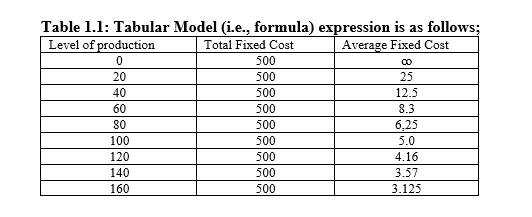
3.Graphical Model
Average Fixed cost graphical model is an expression of the relationship between total fixed cost and total units produced or manufactured of a particular product using a graph.
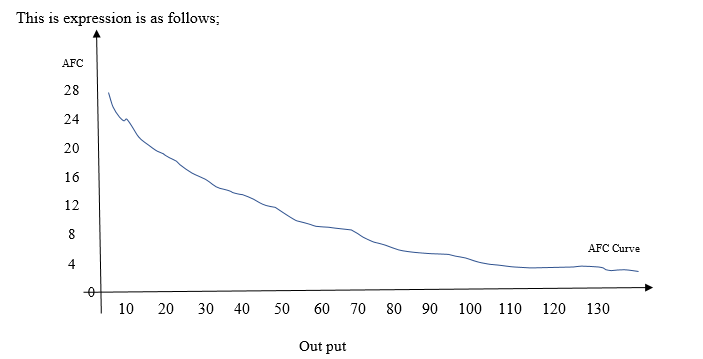
Before I shed light on the advantages and disadvantages of Average Fixed Cost (AFC), it is good to know that this type of cost originates from Total Cost (TC).
Advantages of Average Fixed Cost
Before highlighting the advantages and disadvantages of average fixed cost, it is good to mark this. That AFC is derived from fixed cost and it entails averaging all the outputs in different levels of output with a constant cost. So, the following are some of the advantages of AFC.
1. Portrays the economies of scale
The producer is able to take advantage of a constant cost or fixed cost to maximize in output within the short period. This is because given a certain level of cost, the producer can take advantage of producing more without a corresponding increase of cost.
2. Provide guidance on the number of production inputs to utilize
The constant cost reduces with increase in output and it is possible for the producer to know at what point in time he/she may need to add more inputs in production.
3.Guaranteed of profitability
Average fixed cost decreases as production level increases. This is a sure way that the firm will continue making profits.
4.Cheap prized product
In a case of average fixed cost, goods or services being offered can be sold cheaply and this increases the market share of the firm.
Disadvantages of Average Fixed Cost
- Cumbersome to compute
It is not a simple formular to follow especially for the owners of small and medium businesses
- Complexity in determining fixed cost elements in the available economic resources
Determination of the basis to be used to guide on how cost elements are to be classified as constant or fixed is not universally accepted and hence it is hard to compare two or more companies’ financial performance.
2.3 Average Variable Cost (AVC)
2.3.1 Definition:
Average Variable cost is variable cost per unit. It is the total variable cost associated with production of one unit of a product (i.e., product can either be physical good or service).
2.3.2 Types of Average Variable Cost Models
1.Mathematical Model (i.e., formula)
Average Variable cost mathematical model is an expression of the relationship between total variable cost and total units produced or manufactured of a particular product using a mathematical formula.
Mathematical Model (i.e., formula) expression is as follows;

2. Tabular Model
Average Variable cost tabular model is an expression of the relationship between total variable cost and total units produced or manufactured of a particular product using a table.
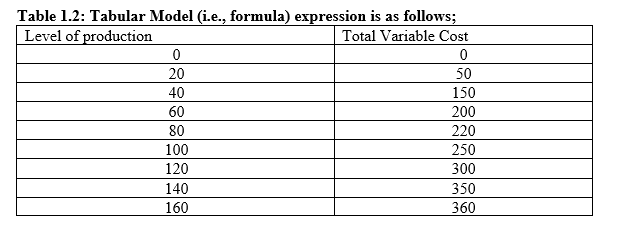
3 Graphical Model
Average Variable cost mathematical model is an expression of the relationship between total variable cost and total units produced or manufactured of a particular product using a mathematical formula.
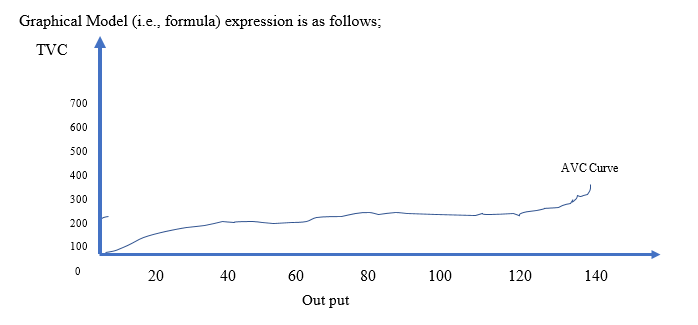
Before I shed light on the advantages and disadvantages of Average Variable Cost (AVC), it is good to know that this type of cost originates from Total Cost (TC).
Advantages of Average Variable Cost
1.. Portrays the cost per unit as output levels change
When the focus is on the output levels, it is possible for the producer to know whether economies of scale is functional or not.
2.. Simple to compute
Since the formula entails factoring only costs associated with the levels of output, then determination of average cost is simple to establish.
3.Yard stick for pricing of goods
Since this is the only element of total cost that vary, the producer relies much on that change to know how to set the selling price of the goods.
Disadvantages of Average Variable Cost
- Not realistic
The model is not realistic for there is no single case where by production will take place without fixed costs. In other words, it is not possible to assume that when the level of production is zero that there is no other costs associated to production.
- Partial representation
Average variable cost excludes other costs and therefore it is not efficient enough to establish the selling price of a product.
2.4 Average Cost (AC)
2.4.1 Definition:
Average cost is total cost per unit. It is the total cost associated with production of one unit of a product (i.e., product can either be physical good or service).
2.4.2 Types of Average Cost Models
1.Mathematical Model (i.e., formula)
Average Cost mathematical model is an expression of the relationship between total cost and total units produced or manufactured of a particular product using a mathematical formula.
Mathematical Model (i.e., formula) is expressed as follows;

2.Tabular Model
Average Cost tabular model is an expression of the relationship between total cost and total units produced or manufactured of a particular product using a table.
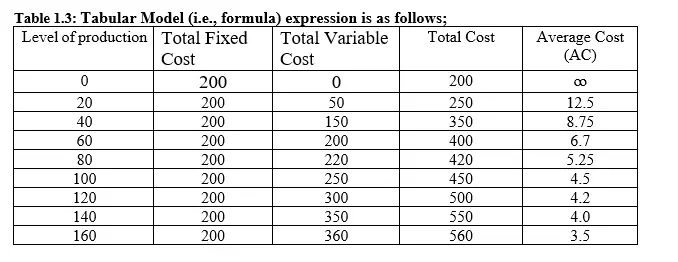
3.Graphical Model
Average Cost graphical model is an expression of the relationship between additional cost and additional unit produced or manufactured of a particular product using a graph.
It is expressed as follows;
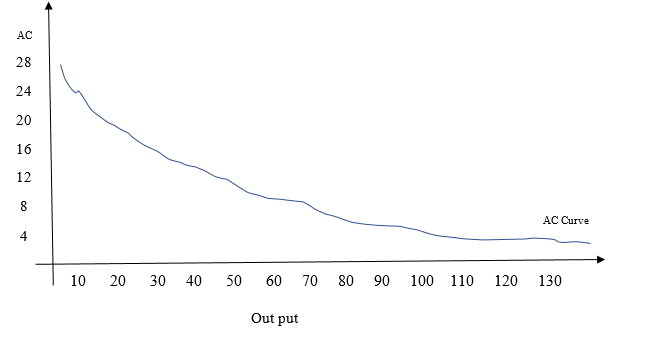
Before I shed light on the advantages and disadvantages of Average Cost (AC), it is good to know that this type of cost is also referred to as Total Average Cost (TAC) and it originates from Total Cost (TC).
Advantages of Average Cost (AC).
1.It is an all-inclusive model
It is an all-inclusive model for it incorporates all the elements of cost such as fixed costs, variable costs and semi-variable cost.
2.Helpful in computing selling price
Since average cost is a uniform cost or cost per unit, it can be used as a benchmark to set the selling price of a commodity.
3.. It can be used instead of marginal cost
Incase marginal cost or cost of producing an additional product, this parameter can be used instead.
4.. Building block for the envelope curve model
The envelope curve theory is a model that is used to demonstrate the working of economies and diseconomies of scale. The average cost element is used in establishing this model/theory.
Disadvantages of Average Cost (AC).
- Cumbersome in computing
It is not a simple model to compute for it has several components to factor in.
- Not commonly computed by owners of small firms
It is not commonly relied on by entrepreneurs especially when setting selling price for they go by the forces of demand and supply.
2.5 Marginal Cost (MC)
2.5.1 Definition:
Marginal Cost is additional economic resources used to produce an additional unit of product (i.e., product can either be physical good or service).
2.5.2 Types of Marginal Cost Models
1.Mathematical Model (i.e., formula)
Marginal Cost mathematical model is an expression of the relationship between additional cost and additional unit produced or manufactured of a particular product using a mathematical formula.
Mathematical Model (i.e., formula) is expressed as follows;

2.. Tabular Model
Marginal Cost tabular model is an expression of the relationship between total cost and total units produced or manufactured of a particular product using a table.

3.Graphical Model
Marginal Cost graphical model is an expression of the relationship between additional cost and additional unit produced or manufactured of a particular product using a graph.
Graphical Model (i.e., formula) expression is as follows;
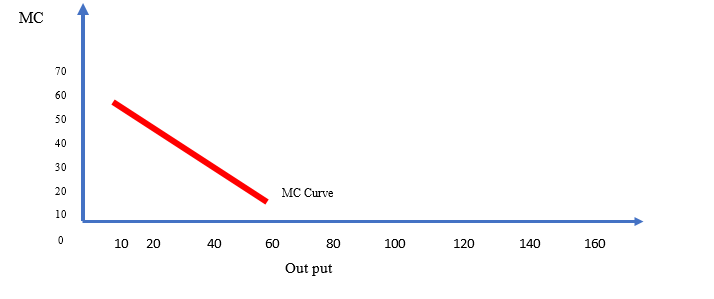
Before I shed light on the advantages and disadvantages of Marginal Cost (MC), it is good to know that this type of cost originates from Total Cost (TC).
Advantages of Marginal Cost
1.. Used in determining the model for a profit maximizing firms
Marginal cost is a component of portraying a case of profit maximizing firms. This is because one of the conditions for a profit maximizing firm is that MC=MR.
Where;
MC is Marginal Cost
MR is Marginal Revenue
2..It can be used instead of average cost
Incase average cost is missing, this parameter can be used instead.
3.. Helpful in decision making
When deciding on how economical it is to continue producing a particular product, the marginal cost really help in making that particular decision which helps in ensuring production is economical.
4.. Help in resource allocation
Marginal cost is a yard stick in determining the best or optimal way of allocating scarce resources.
5.. Acts as the boundary between normal profits and supernormal profits
When the marginal cost is equal to marginal revenue, (i.e.. MC=MR), this turns to be a case where the firm is making normal profits. Anything above the normal profit is supernormal profit.
Disadvantages of Marginal Cost
- Duplication of efforts
When one is computing marginal cost is like computing the cost per unit and the same thing applies in the case of computing average cost. It is the same value.
- Not easy to compute
Marginal cost is complicated when computing for it is only common to Economists and not to other fields. So, most of the time wrong components are used which turn to be complicated.